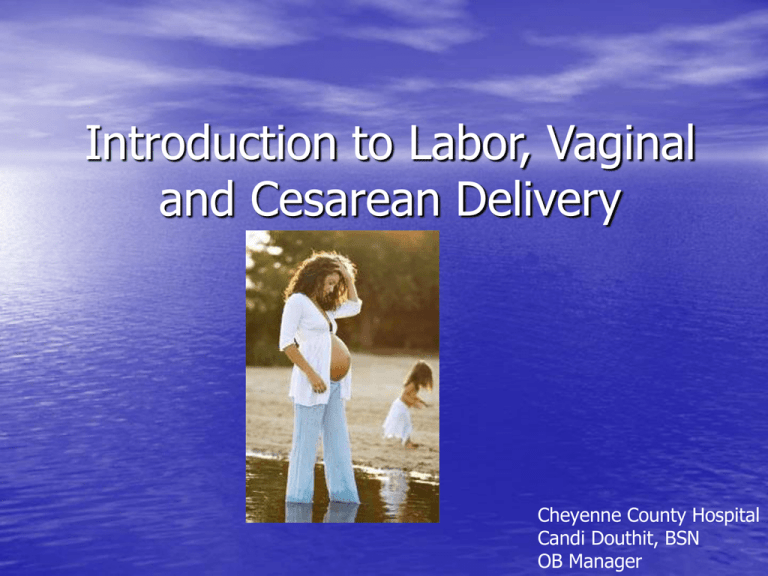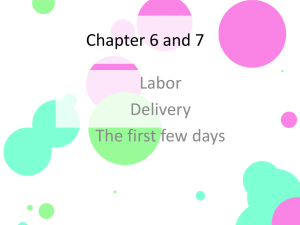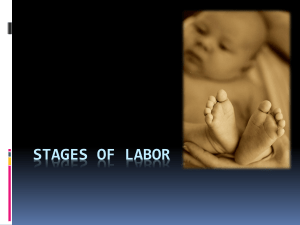Introduction to Labor, Vaginal and Cesarean Delivery
advertisement

Introduction to Labor, Vaginal and Cesarean Delivery Cheyenne County Hospital Candi Douthit, BSN OB Manager Understanding Labor and Delivery • Every labor is different • Despite modern medicine, we can’t predict what • • • will happen Being prepared with knowledge, helps you and your spouse be calmer and less stressed You are never alone You have every right to ask for things to be the way you want them to be Types of Delivery • Vaginal Delivery: most natural, baby descends • • • through the vaginal canal for birth Cesarean Section: major abdominal surgery, cut in the abdomen which baby is delivered through Instrumented delivery: use of vacuum or forceps There are indications for all types. Types of Delivery • Despite the type of delivery you are planning, it is important to know about all of them • Best plan is to keep in mind that our most important goal is a healthy mom and a healthy baby. Symptoms your body is Preparing for Labor • • • • • • • Backache: persistent dull ache Cramps: mild to moderate discomfort PMS symptoms: crabby, irritable Nesting Urge Frequent, soft bowel movements Flu-like symptoms Baby “drops” Impending Signs of Delivery • Mucous plug – May be thick mucous, blood tinged or not – It is normal after a vaginal exam to have brownish/red discharge d/t the trauma of the exam • Water breaks – 80% of time you will go into labor after – Note the color, any odor, amount – Go the hospital Contractions • Braxton Hicks: irregular or regular, may come and go, short while or several hours • “False Labor” doesn’t mean they don’t hurt and doesn’t mean they aren’t doing anything to prepare for delivery Contractions • Contractions of Active Labor – Progressive, get stronger and stronger, closer together – Felt in the back, abdomen, or both. May start in the back and radiate forward – Usually increase with activity – Don’t go away with rest or fluids Other signs you are in “Active Labor” • Dilation of the cervix with vaginal exam – Labor check-2 exams, one hr apart • The contractions just don’t stop When to go to the hospital • Contractions are 3-5min apart and don’t go away with rest/fluids • Water breaks • If you’re having contractions, and/or your water breaks and you are scheduled for a c-section • http://www.youtube.com/watch?v=2EnRV 31mjZY Induction of Labor • • • • Means we artificially start the labor process Done for medical and personal reasons Only after 39wks, unless medically indicated Associated with increased pain, interventions and cesarean delivery (forces your body to do what it may not be ready to do) What to bring to the Hospital • Insurance card and preadmission packet • Your glasses, even if you wear contacts normally…may want to take them out. (Don’t forget contact case and solution) • Toiletries-things you might want during your stay • Comfortable lounging clothes • Slippers and a robe • Light reading • Massage oils, lotions, favorite music, favorite pillow, movies, whatever you need to relax • Massage tools, aromatherapy What to bring to the Hospital • For your husband/support person: – Change for the vending machine – Snacks, snacks, snacks-fridge in the room – Toiletries-no smelly breath! – Clothes, something for you to sleep in – Something to read, DVD player, computer – Camera, video camera, extra batteries What to bring to the Hospital • After you have the baby: – Clean lounging clothes (we have disposable underwear and pads for you) – Snacks! – Nursing Bra (we have lanolin and all of the things needed to get your breastfeeding off to a good start) – Phone numbers – Going home outfit What to bring to the Hospital • For Baby: – Onesies – Going home outfit – Blanket, if you want – We supply everything you really need What to expect at the hospital • Fetal heart monitoring • Vital signs • IV • Vaginal exams-determine your progress – Done by RN or provider – Effacement, station, dilation, pg 34-35 – Not done on a schedule, just when needed Vaginal Delivery • Vaginal Exam cont.: – Effacement 0-100% – Dilation: 0-10 – Station: location of baby’s head in relation to spines of the pelvis, -4 to +4 • http://www.babycenter.com/stages-oflabor What to Expect During Labor • Progression of contractions • Progression of pain • To move • Verbalize your needs to your support team Labor • Labor is the transition point, going from individual to mother, from couple to family. Hence with the transition you have many changes: – – – – Physical-labor changes, pain Emotional-fear, stress, anxiety Intellectual-can I be a mom, will the baby be ok Loss of control-we don’t like to be vulnerable or out of control, creates fear Labor • Average 12-16hrs for first baby • Is difficult and painful, even with drugs • Your body instinctively knows what to do • Your body gives you time between contractions to rest and prepare for the next one Stages of Labor • Stage One-onset of labor to 10cm dilation – Early Phase Avg 8hrs – Active Phase Avg 4-5hrs – Transition Phase 30 min to 2hrs • Stage Two-10cm to birth of baby, 1 contraction to 2hrs -laboring down, pushing, delivery • Stage 3-delivery of the newborn to delivery of the placenta, 5-30min Stage One of Labor • 1. Early Phase – – – – Start of labor to 3cm Feel very social, excited, anticipatory Conserve energy Longest phase, one you are most comfortable in • 2. Active Phase – 3-7cm dilation – Contractions are stronger and more intense, regular – Need to concentrate on the work at hand, no longer social – Relaxation techniques helpful here Stage One of Labor • 3. Transition – 7-10cm dilation – Hardest but shortest stage – Contractions are very intense and feel they come one after the other – Pressure in the perineum as the baby comes down Labor: Stage Two • May feel the urger to bare down • Push when the physician tells you to do so • Prior to this you have been cooperating with your body, now you will actively work with your body to deliver the baby • With each contraction you will bare down and move the baby through the birth canal Labor: Stage Three • Birth of the baby • Focus on the baby • Several more labor-like contractions will come then delivery of the placenta (physician will massage your belly to facilitate this) • Breastfeed or just watch and touch your baby Live Natural Birth • http://www.babycenter.com/2_live-birthnatural_3656508.bc Instrumented Delivery • • • • • Vacuum Episiotomy-don’t do unless necessary Forceps Complications occur in labor and delivery. Can’t always be predicted, just have to react when they occur. We will tell you what is going on throughout if this occurs. http://www.babycenter.com/2_vacuum-andforceps-during-birth_3656512.bc Cesarean Section Birth • Indications: prior c-section, infant complications, mother complications • Know that any delivery can go to a cesarean section at any time….again, our goal is a healthy mom and a healthy baby • If mom or baby has complications, this will happen very quickly, goal is delivery within 30 min. What to expect for a scheduled c-section? • Arrive early in the morning • To sign consents, talk to the CRNA, complete paperwork (nurses do this online) • Labs drawn day before or morning of • IV, catheter, tight-fitting hose • Fetal monitor • Support person will put on scrubs Risks of Cesarean Delivery • Mother – – – – – – – – – Longer hospital stay Increased blood loss Infection Injury to bowel, bladder, ureter Blood clots Anesthesia complications Pain Admission to the ICU Hysterectomy Risks of Cesarean Delivery • Baby – Not squeezed, so increased breathing complications – Less immediate contact with mom – Longer till breastfeeding is initiated – Scalpel injury – Fetal death Risks of Cesarean Delivery Risks for future pregnancy and birth: Repeat cesarean is likely Placental accreta Pre-term labor and lower birthweight baby Placental abruption • Placenta previa • Ectopic pregnancy • Increased risk of uterine rupture http://www.babycenter.com/2_live-birth-c-section-surgery_3656510.bc Role of the Support Person in Labor and Delivery Support Person Job Description • You are the second most important person in • • the room You know mom best, can best “read” her, and will know what she needs throughout delivery, she will hear you better than the rest of us Together, this is your birth experience, not your wife’s and the health care staff. Take an active role in the labor process. Support Person Job Description 1. Emotional supporter 2. Provider of reassurance 3. Reminder of class content 4. Time officiate 5. Sharer of what makes her feel best 6. Hand holder, brow mopper 7. Family liaison 8. Photographer, baby and mom assistant 9. Breastfeeding helper 10. Bouncer Support Person Job Description • Your job if so very important, post delivery, mom needs a lot • Hormonal shifts, mom needs support • Need to stay overnights to help with baby and learn how to be a dad! • See support person handout as well! Questions???









